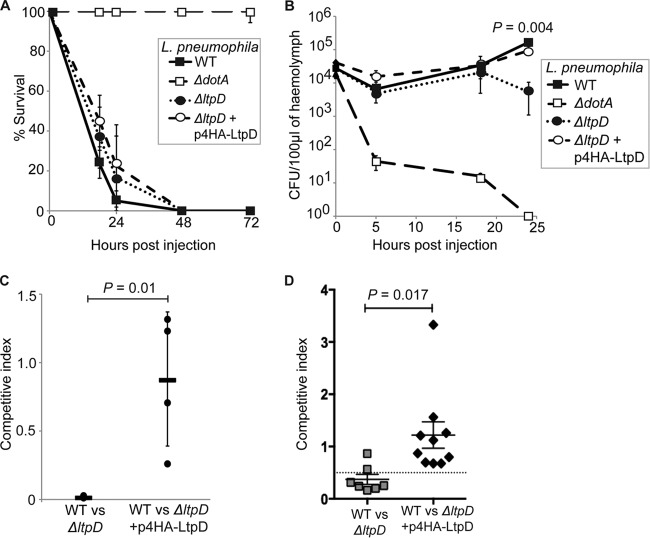Fig 7.
LtpD has a role in in vivo infection models. Ten G. mellonella larvae were infected with 107 L. pneumophila 130b (the WT, ΔdotA strain, ΔltpD strain, or ΔltpD strain expressing 4HA-LtpD). (A) The ΔltpD strain did not affect larval mortality under these conditions. (B) The hemolymph of infected larvae was extracted at 0, 5, 18, and 24 h p.i., and the CFU were quantified. The ΔltpD strain replicated at the same level as the WT over the first 18 h but displayed at 24 h p.i. a significant drop in CFU (P = 0.004, unpaired Student t test), which could be complemented by the addition of 4HA-LtpD on a plasmid. The results in panels A and B are means of at least three separate experiments ± the standard deviations. (C) Larvae were injected with the WT and either the ΔltpD or ΔltpD (p4HA-LtpD) strain in a 1:1 ratio, and the ratio of WT to each mutant was calculated at 24 h p.i. The WT significantly (P = 0.01, unpaired Student t test) outcompeted the ΔltpD strain. Each point represents a separate experiment (from the pooled hemolymph of three larvae), while the bars show the means ± the standard deviations. (D) Pulmonary infections of A/J mice with L. pneumophila 130b WT and either the mutant ΔltpD strain or the ΔltpD(p4HA-LtpD) strain in a 1:1 ratio were introduced into the lungs of A/J mice by intratracheal inoculation. At 72 h p.i., the ratio of the WT to the ΔltpD strain in infected lungs was determined. The ΔltpD strain was outcompeted (CI = 0.372) by the WT in the mouse lung, and this effect could be complemented. The data are representative of actual values obtained per mouse, and a solid bar represents the mean value (P = 0.017, unpaired Student t test).

